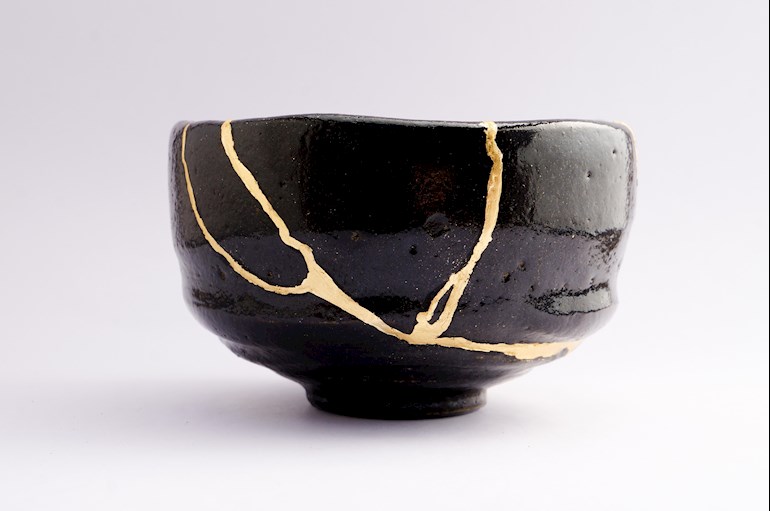"Lessons From The Japanese Art of Kintsugi
." The following is an adaptation of an article that inspired me to consider the image above: This beautiful, oddly-shaped and broken vessel, healed with gold, as a metaphor for my own life and journey with prostate cancer.
Most people don’t purposefully shatter their cherished pieces of pottery, but that isn’t always the case in Japanese culture. Adorning broken ceramics with a lacquer mixed with powdered gold is part of a more than 500-year-old Japanese tradition that highlights imperfections rather than hiding them. This not only teaches calm when a cherished piece of pottery breaks; it is a reminder of the beauty of human fragility as well.
In a world that so often prizes youth, perfection and excess, embracing the old and battered may seem strange. But the 15th-Century practice of kintsugi, meaning “to join with gold”, is a reminder to stay optimistic when things fall apart and to celebrate the flaws and missteps of life.
The kintsugi technique is an extension of the Japanese philosophy of wabi-sabi
which sees beauty in the incomplete and value in simplicity. The broken pieces’ gilded restoration usually takes up to three months, as the fragments are carefully glued together with the sap of an indigenous Japanese tree, left to dry for a few weeks and then adorned with gold running along its cracks.
In an age of mass production and quick disposal, learning to accept and celebrate scars and flaws is a powerful lesson in humanity and sustainability. - Yasmin El-Beih
Personal life planning and navigating our PC journey, both for patient warriors and for our heroic caregivers, is most often an exercise in trial-and-error or course corrections management, more than the pursuit of perfection.
Indeed, the best plans are those written in pencil, where numerous erasures are visible. They are novels that remain forever in draft form, in which the author continues to build on the narrative, charting out a series of compelling contingencies and Plan B’s and C's.
But these divergences from Plan A, the unfinished story, the erasures and adjustments, all add to the texture of the plan more than they detract. Even more so is that we invevitably accumulate injuries, traumas and lost capacities, in every arena of our lives: physical, emotional, mental, social and financial. And most keenly on the levels of personal relationships. The whole amounts to a patchwork of brokenness mixed with incomplete healing which brings more character and depth to our being.
It is not unlike the 500-year-old Japanese practice of kintsugi.
The translation of kintsugi is “golden joinery,” and it is an art form in which broken pottery is fused back together by precious metals, like gold, platinum, or silver. This technique isn’t a mere exercise in scarcity or frugality; it is a philosophy from which we can draw direction and inspiration for more effective—and a more rich and meaningful life journey.
Here are four principles of kintsugi that can instruct our own life journey:
1.That which is broken can be mended. Flaws or losses and how can be sources of character strength and depth . Of compassion and wisdom. That which we can ring forward into our relationships and offer to others.
2. Where we are broken, can be features: Of our character. Testimony to heroism and depth of love. Who can deny the beauty of a grieving caregiver wife who has lost the battle along with her husband, who carries the "brokenness" of PTSD and depression? And now is inspired to take that suffering to bring support forward to other caregivers. How beautiful and honorable is that? It is gold indeed.
3.There is “ beauty in the incomplete.” Kintsugi draws from the Japanese philosophy of wabi-sabi—“wabi", which roughly means ‘the elegant beauty of humble simplicity, and "sabi", which means ‘the passing of time and subsequent deterioration.’” And our life journey never reaches a point of completion. Indeed this is true for advanced prostate cancer. It is our harsh teacher for life.
4.Lastly, it must be acknowledged that the process of healing and adjusting to what PC and its treatment has cost us takes time. “The broken pieces’ gilded restoration takes months, as the fragments are carefully glued together with the sap of an indigenous Japanese tree, left to dry for a few weeks and then adorned with gold running along its cracks.” The one theme that is likely common among the host of intentions and stages of our life journey is that they will take time to unfold.
It is important to be mindful that neither kintsugi nor in crafting our best possible life's journey, and adjusting to all of our challenges and losses, is formless. There is a mold that is created, we fit the pieces together in the best possible way, bringing every resource and strategy to bear toward the highest dignity of life and capacity towards which we strive. Without intentions, there is no plan and we end up wherever circumstances dictate. Without objectives, we are merely the means in someone else’s planning.
Personal treatment and life planning, like kintsugi, doesn’t encourage passivity or glorify failure. Rather it frees us from the momentary paralysis of missteps, invites us to move on from every obstacle and treatment failure. Teaches us how to put the pieces back together, and allows us to celebrate the gift of life and our relationships, bonded, healed and adorned by our lessons learned.
Where have we each been broken? How has the patient mending taken place and restored a new sort of wholeness? Can we recognize and honor the beauty of such golden mending in ourselves and in others?
